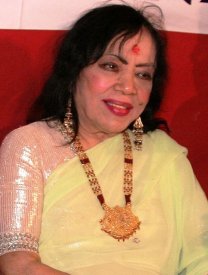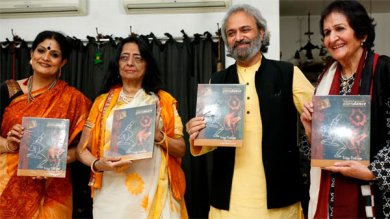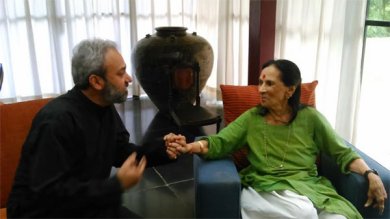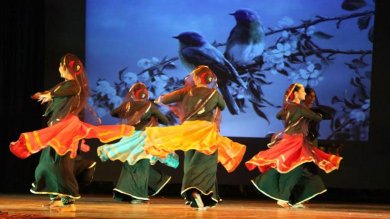
|   |

|   |
Sitara, Tara and Travels of Dance (Books) - Ashish Mohan Khokar e-mail: khokar1960@gmail.com November 29, 2014  Sitara Devi Nov 25, 2014, the TV news channels first gave the news - Sitara Devi no more. It made national news because she was a firebrand, diehard dancer with spunk and substance. She was larger than life and lived life king-sized. Born Dhanno to a reputed tabla wizard and Sanskrit scholar Pt. Sukhdev Maharaj and Matsya Devi, the three sisters Tara, Sitara and Alaknanda (and two brothers Chaube and Pande) were a popular trio, before individual fates took them to places as far as Benaras, Bombay and Bengal. Although Sitara was born in Bengal (8th Nov 1920), she lived most of her adult life in Bombay, with brief stay in Benaras. Her sister Tara was the mother of Gopi Krishna, another famous film dance personage. Her father was court artiste in Nepal, then Benaras, but fate brought his child prodigy of a daughter to work in Hindi films in Bombay as early as 1930s and she got her first film dance break in Usha Haran (1940), then Nagina (1941), Vatan (1954) and Anjali (1957). Till her Holi Dance (dressed up as a boy!) in Mother India (1957), she continued to delight audiences with her oomph and freestyle dance. Not shy of the stage or the camera, she was at home in the medium for which she was born. Her whole life has been spent in front of public gaze, in 3 marriages (to Nasir Ahmed, then K. Asif and finally to Pratap Barot), in countless public stands she took. Sitara Devi had nothing understated about her. Her colours and costumes, bangles and emotional tangles were for all to see. She lived her life cinemascope! Given a Padma Vibhushan Award in 2001, she declined saying she deserved a Bharat Ratna. At launch of attendance 2002 issue, just retired PM Inder Gujral heaved a sigh of relief and said, "I'm glad I was not the PM when she refused the award!" Such was Sitara's ire and energy that scared even the best of men. Making a documentary on her for Mohan Khokar Archives, some ten years ago, we ran out of Beta tapes since she spoke and danced nonstop for 8 hours without pause! Of course, she was fussy about lights, lack of lubricants and when we invited her to dinner, she said she took only liquid diet after a long day's work! Sitara Devi was genuine. She was 24 carat gold, inside out. What she was, she was. She was pure hearted. In all she did, there was no pretence, no fake, surface level nakhras. She was a true artiste, large hearted and generous. She gave away what she earned, lived like royalty and indeed behaved like one too! She was pucca about music and rhythm and it's no wonder her son Ranjit Barot is a master of drums and daughter Jayantimala is a dancer. She was very protective about her children and caring. She had many skirmishes with ill health and illness but never gave up. In the end, she died on 25th Nov 2014, just two buildings away from her Peddar Road flat at Jaslok hospital. When we look up today, the bright star that dances and shines must surely be Sitara, having a dance party up there, in the heavenly skies. A book on her is due. Who will publish it and more importantly, who will buy? Dance books are far and few in a given year. Maximum 5 in a good year. Of these, two are vanity press variety (that means dancers writing about themselves), 2 are unreadable because they are meant for university types, footnotes and all and one is a coffee table book (so expensive that in the end one can afford a coffee not the table or the book!). Every year, we have just single digit releases, which is why dance magazines and journals become important. Blogs and FB, by definition are personal points of view and while engaging, are of no lasting value. Only one dance portal - narthaki - has stood the test of time by giving important news, views and information (including addresses and some academic columns) thanks to able steering provided by Anita Ratnam and Lalitha Venkat. Even at the cost of sounding self promotional, I take up the cause of dance magazines. Marg is oldest, almost 70 plus years now. Backed by Tata Press in Mumbai and Tata monies (many ads came from Tata sister concerns to keep it solvent), Marg was a byword in art documentation. Each issue was a Collector's item. Very majorly eminent people of India like Karl Khandalwala, Mohan Khokar, Mulkraj Anand, Saryu Doshi were its editors or guest editors. Alas! It died a slow death, was revived and then again went comatose. Pushpanjali was another very well brought out arts journal brought out from Mumbai. Alas, dead. Sruti from Chennai is now the oldest, about 30 years now and it started off as a music mag, that too just south Indian music. See old issues masthead and it states so. Then it added north Indian music, then ten some years later, dance. It has a good mix of views, reviews (too dated sometimes to be in a monthly, say April event appearing in December) and it is mostly south Indian in look, feel and flavour. But it is a standard journal or monthly. It has served its purpose as a standard performing arts magazine, now that it has gone full colour and also has an App and an e-edition. It is well managed by a small team, of whom S. Janaki is the continuity. Pattabhiraman, who was a jazz fiend and by his own admission "knew nothing much about Indian classical dance music" started it upon retirement from his UN job. Then attendance is second oldest at 17 years. Yearbook, still not on Facebook! Nartanam is third in line, originally started for promotion of Kuchipudi. It is a quarterly in black and white with scholarly articles and reviews. From Nagpur comes Deepbhava and from Bhopal, Mudra, both in Hindi. Any mag/journal is welcome, as there are so few in India.  Attendance release in Delhi: Geeta Chandran, Yamini Krishnamurthy, Ashish Khokar, Shanta Serbjeet Singh attendance was Mohan Khokar's idea of putting between two covers all that happened in a year, of note. He felt (prophetically so) that newspapers were abdicating their social responsibility and soon there would be less space for dance. It happened within years of his dying, hence prophetic. He was a visionary, far ahead of his times. I took up his idea and now 16 years later, I realize a mistake I've been doing for past 15 years. I have been selling attendance as an annual, a journal, whereas it is a book, hardbound no less. Each issue addresses a subject and then adds other happenings and benchmarks in the year. In 1999, we started off with soft cover but libraries would not buy saying they need hard covers to last on shelf. So we fell on hard times, trying to get hard bound issues and supply to libraries. Libraries still didn't buy because they said dance was not a serious subject! They placed it under Hobby shelves, along with Gardening books and "How to make Dhokla." Even mainstream bookshops did the same; all the fancy names in market had no interest in dance. In 15 years, we have shifted the paradigm and now dance books are exclusive and in some fancy malls, there is a dance section! It has taken me 15 years to break even with a dance journal that's a book, it is hard bound and now sells before we print. Every now and then I get a Guest Editor to undertake an issue and this Telugu Traditions has been a stupendous collaboration with dynamic Dr. Ananda Shankar Jayant. She has upped the ante as it were, lavished the product with care and comfortable margins and made the yearbook stand out. She with designer Pratima Sagar, have made it a benchmark issue. Attending NADAM festival in Bangalore, one was saddened at state of NRI Bharatanatyam. They come in season to be seen and get reviews which they add to their hefty bios but their dance is without any evident feeling. In item after item they do, clear and clean lines and all, best araimandis and make-up but no emotion. BN abroad, especially in US of A, is like eating the banana skin and throwing the fruit. Why are most dancers so clinical? One local dancer who made an impact was Rukmini Vijayakumar. She had energy and new aesthetics. Although she was like a peacock (false eyelashes and all) her group and presentations had some novelty, even if the feel was 1950s. Rukmini looks like junior Shobana and Priya rolled in one, but her cold, pretty polly face undoes her beautiful dance. Yet, she is something new and special to watch in BN. 'Kathak through the Ages' was guru Maya Rao's last production and it was handsomely compiled, even if dancing abilities of most dancers in Kathak style is minimal. Madhu Nataraj remained centrepiece, while Janardhan and Kirti Kumar tried to add spine to the production. Nadam's own Kathak has good foundation though variety in items is limited. Their guru Dharmsiji Shah was present all three days of the fest to bless. At 95, he remains a sturdy example of how dance can keep one young. It was left to Ratikant Mohapatra to show standards in choreography; strengths of supreme aesthetics in music, lights, dance, costumes and choreography. Ratikant does his lineage proud and he is now a gem of Odisha. He has outshone himself. Nadam festival (like many others) needs to curate content seriously in future. Not just oblige any dancer visiting from abroad. There is enough talent in India, in Bangalore and in the south. Rasadhwani's 7 day academic festival Suruchi in Ahmedabad (reviewed already in narthaki) showed how dependent they were on outside talents, especially Bombay. It was a week of Nalanda in Ahmedabad! Fortunately, Nalanda standards are good under eagle-eyed Kanak Rele, its creator and pillar. Vaibhav Arekar, Malathi Agneswaran, even a slimmed and toned down Uma Rele was part of this festival, where many young students from all over Gujarat and Bombay, came to attend. Uma Anantani is blessed with twins, Shivangi and Gargee, who handled the feat of hosting 200 folks for a week. The morning seminar proceedings and evening dance festival was academic in nature and made a big impact on residents of Ahmedabad. Uma Anantani stands complimented, to mount this against all odds. Dr. Suresh Desai was the fulcrum.  Ashish Khokar with Mrinalini Sarabhai  Devaniya In Ahmedabad, it was natural to meet and greet Mrinalini Sarabhai and Mallika busy as a bee hosting a major production at Natarani. Amma at 96 looks resplendent and is the most gracious dancer-guru I have come across in my life. As Gowri Ramnarayan once commented, class shows. Parul Shah in Baroda is mounting the biggest impact on dance, a networked course for students. Many mainstream dance educationists and teachers are contributing to this feat Books travel. But dancers must read and support the written word. It's not only about their glory or publicity. It is about the art form itself. How will dancers reach out and last if they are not written about? No one will grant an award or a show seeing a personal blog or personal site. For that there has to be an assessment. Only qualified, long term observers can do that. Which is why critical writing is important, not PR type reviews. I end on a high note and what can be higher than spirituality in Indian dance. And this is sufi spirituality. Jigyasa with her Devaniya school put up a kaeliodoscopic Kathak show, full of colours and costumes that were a delight and excellent tayari and foundation in the form. There is so much overdose of Bharatanatyam in Chennai, that anything else looks refreshing. To train over a 100 students and train them equally well is commendable and credit goes to guru Maya Rao's foundation, whose shishya Jigyasa is. November ends with attendance annual awards and more of such awards in my next column. Au Revoir! Ashish Mohan Khokar is a reputed dance historian, biographer, critic and author of many published articles and over 40 books on Indian arts and culture. He served govt. bodies in many capacities and also teaches Indian dance history and aesthetics for university faculties. He is the curator of the Mohan Khokar Dance Collection and chairs the Dance History Society which hosts an annual convention and dance discourses that afford many talents a platform. He has mentored many and instituted five awards through attendance, the dance yearbook he edits and publishes. Post your comments Pl provide your name and email id along with your comment. All appropriate comments posted with name and email id in the blog will also be featured in the site. |